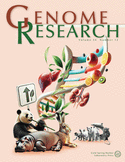A high-resolution association mapping panel for the dissection of complex traits in mice
- Brian J. Bennett1,10,
- Charles R. Farber2,10,
- Luz Orozco1,10,
- Hyun Min Kang3,10,
- Anatole Ghazalpour1,
- Nathan Siemers4,
- Michael Neubauer4,
- Isaac Neuhaus4,
- Roumyana Yordanova4,
- Bo Guan4,
- Amy Truong4,
- Wen-pin Yang4,
- Aiqing He4,
- Paul Kayne4,
- Peter Gargalovic5,
- Todd Kirchgessner5,
- Calvin Pan6,
- Lawrence W. Castellani1,
- Emrah Kostem7,
- Nicholas Furlotte7,
- Thomas A. Drake8,
- Eleazar Eskin6,7,11 and
- Aldons J. Lusis1,6,9,11,12
- 1 Department of Medicine/Division of Cardiology, David Geffen School of Medicine, University of California, Los Angeles California 90095, USA;
- 2 Department of Medicine, Department of Biochemistry and Molecular Genetics and Center for Public Health Genomics, University of Virginia, Charlottesville, Virginia 22908, USA;
- 3 Computer Science and Engineering, University of California, San Diego, California 92093, USA;
- 4 Department of Applied Genomics, Bristol-Myers Squibb, Princeton, New Jersey 08543, USA;
- 5 Department of Atherosclerosis Drug Discovery, Bristol-Myers Squibb, Princeton, New Jersey 08543, USA;
- 6 Department of Human Genetics, David Geffen School of Medicine, University of California, Los Angeles, California 90095, USA;
- 7 Department of Computer Science, University of California, Los Angeles, California 90095, USA;
- 8 Department of Pathology and Laboratory Medicine, David Geffen School of Medicine, University of California, Los Angeles California 90095, USA;
- 9 Department of Microbiology, Immunology and Molecular Genetics, University of California, Los Angeles, California 90095, USA
Abstract
Systems genetics relies on common genetic variants to elucidate biologic networks contributing to complex disease-related phenotypes. Mice are ideal model organisms for such approaches, but linkage analysis has been only modestly successful due to low mapping resolution. Association analysis in mice has the potential of much better resolution, but it is confounded by population structure and inadequate power to map traits that explain less than 10% of the variance, typical of mouse quantitative trait loci (QTL). We report a novel strategy for association mapping that combines classic inbred strains for mapping resolution and recombinant inbred strains for mapping power. Using a mixed model algorithm to correct for population structure, we validate the approach by mapping over 2500 cis-expression QTL with a resolution an order of magnitude narrower than traditional QTL analysis. We also report the fine mapping of metabolic traits such as plasma lipids. This resource, termed the Hybrid Mouse Diversity Panel, makes possible the integration of multiple data sets and should prove useful for systems-based approaches to complex traits and studies of gene-by-environment interactions.
Footnotes
-
↵12 Corresponding author.
E-mail JLusis{at}mednet.ucla.edu.
-
[Supplemental material is available online at http://www.genome.org. The microarray data from this study have been submitted to the NCBI Gene Expression Omnibus (http://www.ncbi.nlm.nih.gov/geo) under accession no. GSE16780.]
-
Article published online before print. Article and publication date are at http://www.genome.org/cgi/doi/10.1101/gr.099234.109.
-
- Received August 2, 2009.
- Accepted December 2, 2009.
- Copyright © 2010 by Cold Spring Harbor Laboratory Press











